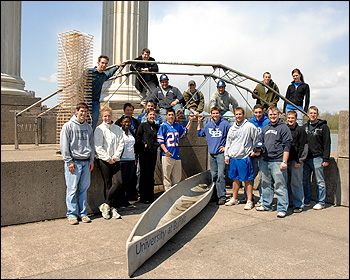Archives
Engineering students excel in competition
Steel bridge, concrete canoe teams take second place in regional contests
By KEVIN FRYLING
Reporter Staff Writer
The UB student chapter of the American Society of Civil Engineers (UB-ASCE) recently took second place overall in competition against engineering teams from institutions including Clarkson, Cornell, Rensselaer Polytechnic Institute, Rochester Institute of Technology and West Point at the 2008 regional ASCE conference hosted by the U.S. Military Academy at West Point.

Two teams from
UB’s student chapter of the American Society of Civil Engineers
took second place in the steel bridge and concrete canoe competitions
held at the regional meeting of the ASCE. The steel bridge team will go
on to the national competition, to be held later this month at the
University of Florida-Gainesville.
PHOTO: NANCY J. PARISI
This year, UB-ASCE had two teams competing in major events, in which students are challenged to create a steel bridge model and concrete canoe, as well as a number of other teams in events that were new to the competition this year. Both teams in major events placed second overall, including first place in stiffness and efficiency for the steel bridge team and first place in women's sprints for the concrete canoe team.
“The invitation for our ASCE student club to compete at the national level against the very best universities in the U.S. and Canada highlights the exceptional quality of UB’s civil engineering program and our students’ commitment to excellence,” says A. Scott Weber, professor and chair of the Department of Civil, Structural and Environmental Engineering, School of Engineering and Applied Sciences. “I am extremely proud of their accomplishments and the distinction they bring to the department, UB Engineering and the university.”
The purpose of the ASCE conference, Weber says, is to provide engineering students with hands-on experience in engineering design and construction, and foster a sense of competition and camaraderie among the participating schools. The challenges also are “just general fun,” he adds.
“The students love these projects,” notes Todd Snyder, an instructor in the Department of Civil, Structural and Environmental Engineering, and the faculty advisor to UB-ASCE. “It’s a lot of work, but they also learn a lot. Their success is really a testament to the students here and the quality of the department.”
The steel bridge competition is designed to educate participants about the conception and design phases of bridge construction, as well as fabrication, erection and testing, culminating in a steel structure that meets client specifications and optimizes performance and economy. The bridges are judged on such criteria as strength, durability, constructability, usability, function and safety, all of which reflect the regulations that govern the design and construction of full-scale bridges. Awards are given in several individual categories, including stiffness, lightness, construction speed, display, efficiency and economy.
The students put a lot of hours into the project, says Thomas Coyne, a senior civil engineering and architecture major from Albertson, N.Y., and leader of the steel bridge team, noting that the team began the design process last fall and completed construction this spring. “Simple design, strength and constructability were all factors,” he adds. “I learned a lot being a part of this.”
The steel bridge team’s superior performance in the categories of stiffness and efficiency has earned Coyne and his teammates a trip to Gainesville, Fla., where they will compete against teams from across the country at the 2008 National Student Steel Bridge Competition, being held at the University of Florida May 23 and 24.
The concrete canoe competition also provides engineering students the opportunity to gain hands-on, practical experience and leadership skills by working with concrete mix designs and project management, as well as raise their awareness about the use of concrete as a versatile and durable construction material.
The greatest engineering challenges in constructing a successful concrete canoe are designing a hull that’s sleek enough to race and creating a concrete mixture that is more buoyant than water, according to Miranda Robinson, a junior civil engineering major from Otego, N.Y., and leader of the concrete canoe team.
“There are also a lot of nonengineering skills that go into the canoe,” she adds. “You need athletes, creative people, artists and engineering.”
The concrete canoe team took second place in the racing section—including first-place wins in the women’s sprint and “fun race”; second-place wins in the categories of women’s endurance, coed sprint and men’s endurance; and a third-place win in the men’s sprint. It also placed second in presentation and in overall final product, and fourth in the design report.
UB-ASCE and the Department of Civil, Structural and Environmental Engineering will host the 2009 regional ASCE conference next April.
In addition to Coyne and Robinson, students participating in the 2008 regional ASCE conference were Raymond J. Cestaro of Whitestone; Justin C. Darling of Clifton Springs; Lenora A. Dunnah of St. Georges, Antigua and Barbuda; David J. Hastings of Carthage; Joseph B. Kasperski of Penfield; Trisha M. Miazga of Saskatoon, Ontario; Antonio Miceli of Spencerport; Alexander C. Niederbuhl of Saranac Lake; Melissa E. Norlund of Petersburgh; Timothy S. O’Donoghue of Avon; Timothy W. Savery of North Tonawanda; Timothy P. Sugrue of Coeymans Hollow; Joseph T. Wetzel of Rochester; Robert D. Wurstner of Buffalo; and Walter J. Zitz of Red Hook.
